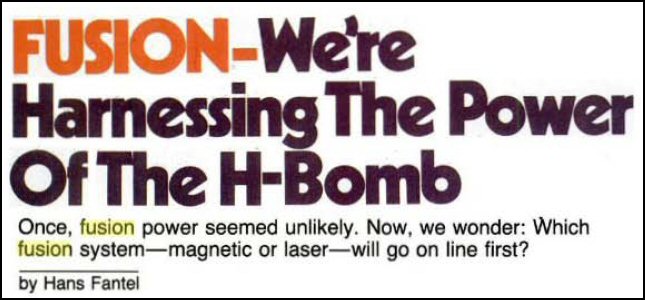52. Princeton Lab Anticipates Fusion Breakeven Within Three Years

by Hans Fantel
The cheapest and most plentiful fuel on earth would be water — if you could burn it. That’s no longer a pipe dream. From the way it looks now, we may soon have practical fusion reactors to liberate the atomic forces in seawater. The world would then have a virtually boundless source of energy.
Atomic fusion — the principle basic to the use of seawater as fuel — has been known since the dawn of the atomic age during World War II. But so far, no practical fusion device has been built (unless you consider the hydrogen bomb as practical). But to gigantic research projects — one at Princeton University, the other at the University of Rochester — are finally getting within spitting distance of producing useful energy from fusion reactions. ...
The latest version of the tokamak has been able to reach stellar temperatures, trigger a fusion reaction and sustain it long enough to generate significant amounts of power. So far, the big machine has managed to keep this up for about 20 milliseconds. To become an efficient energy producer, it will have to run much longer than that — about 10 seconds or more for each power burst. But keeping the tokamak going for so long is very tricky task.
The trouble is that no material on Earth can contain the raging stream of stellar stuff inside the tokamak. If the swirling deuterium touches the wall of the metal tube containing it, the deuterium cloud breaks up, cooling to the point where the fusion reaction falters. So the torrent inside the tokamak must race inside the ring-shaped tube without ever touching its walls. It is, therefore, contained in what is called a magnetic bottle — an ultra-strong magnetic field, shaped to hold the deuterium suspended within the doughnut, away from its walls.
Unfortunately, the bottle still leaks. Often, the hot material breaks through the magnetic restraint, cools off instantly, and stops the reaction. That’s the main reason why the tokamak is still just a research tool, rather than a working power source.
But this may change by the late 1980s. A machine almost twice as big as the present tokamak — called the TFTR, the tokamak fusion test reactor — is nearly completed, and its size alone may help solve the problem. …
Dr. Harold P. Furth, director of the tokamak project, believes that it might break even by the mid-1980s. The breakeven point would be reached when a reaction lasts long enough to generate as much energy as is consumed in the heating process.
Publication Date: September, 1982
Source: Popular Mechanics

